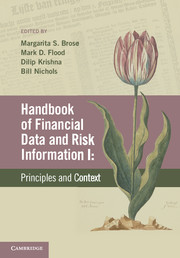Book contents
- Frontmatter
- Contents
- List of contributors
- Preface
- VOLUME I: PRINCIPLES AND CONTEXT
- PART I RISK MANAGEMENT CONTEXT FOR FINANCIAL DATA
- PART II REQUIREMENTS AND SOURCES FOR FINANCIAL RISK MANAGEMENT
- PART III REGULATORY DATA
- 10 A history of financial regulation in the USA from the beginning until today: 1789 to 2011
- 11 Data for microprudential supervision of US banks
- 12 Microprudential supervisory data in the USA: Securities and derivatives
- 13 Financial data and risk information needed for the European system of financial supervision
- 14 Data needed for macroprudential policymaking
- Index – Volume I
- References
14 - Data needed for macroprudential policymaking
from PART III - REGULATORY DATA
- Frontmatter
- Contents
- List of contributors
- Preface
- VOLUME I: PRINCIPLES AND CONTEXT
- PART I RISK MANAGEMENT CONTEXT FOR FINANCIAL DATA
- PART II REQUIREMENTS AND SOURCES FOR FINANCIAL RISK MANAGEMENT
- PART III REGULATORY DATA
- 10 A history of financial regulation in the USA from the beginning until today: 1789 to 2011
- 11 Data for microprudential supervision of US banks
- 12 Microprudential supervisory data in the USA: Securities and derivatives
- 13 Financial data and risk information needed for the European system of financial supervision
- 14 Data needed for macroprudential policymaking
- Index – Volume I
- References
Summary
Introduction and motivation
The recent crisis underscored that ensuring the safety and soundness of individual institutions is insufficient to guarantee that the financial system as a whole is stable and well functioning. This implies the need for a “macroprudential” approach to ensuring financial system stability. That is, by its nature, a view of the aggregate risks and vulnerabilities posed by financial institutions, through markets and through their bilateral interactions, is necessary to adequately understand and mitigate systemic risk.
Although financial crises have occurred throughout history, there are several developments in recent decades, and specifically just prior to the latest crisis, that require a different – a broader – focus for regulation.
• Interactions among individual financial institutions through markets have become faster (due to technological advances) and involve more and different types of institutions than ever before.
• Many over-the-counter markets and bilateral trades make the size and interconnections across institutions difficult to see and monitor, amplified by the growing length of complex intermediation chains.
• Repackaging of exposures in complex products and creation of other tailor-made instruments make risks difficult to assess and monitor.
• Lack of consistent criteria and homogenous reporting standards imply data sharing, even when it occurs, may be suboptimal, making it hard to “connect the dots” to see vulnerabilities to the financial system or spillovers to the real economy.
- Type
- Chapter
- Information
- Handbook of Financial Data and Risk Information IPrinciples and Context, pp. 566 - 592Publisher: Cambridge University PressPrint publication year: 2014



